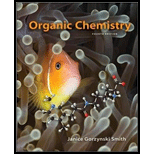
Concept explainers
(a)
Interpretation: An explanation for higher stability of triphenylmethyl radical than other radicals is to be stated.
Concept introduction: The delocalization of lone pair or free electrons from one place to another is known as resonance. The stability of compound depends upon the number of resonating structures. More the resonating structures of compound more will be its stability.
(b)
Interpretation: The dimerization of two triphenylmethyl radicals to form A is to be represented by the use of curved arrow notation.
Concept introduction: The delocalization of lone pair or free electrons from one place to another is known as resonance. The stability of compound depends upon the number of resonating structures. More the resonating structures of compound more will its stability.
(c)
Interpretation: A reason for the formation of A rather than hexaphenylethane is to be proposed.
Concept introduction: The
(d)
Interpretation: An explanation of the use of
Concept introduction: Spectroscopy method is used to identify the structure of the molecule. It is based on the interactions between matter and
Want to see the full answer?
Check out a sample textbook solution
Chapter 15 Solutions
Organic Chemistry - With Access (Looseleaf) (Custom)
- Give the reagents and results/observationarrow_forwardPlease answer this NEATLY, COMPLETELY, and CORRECTLY for an UPVOTE. What is the purpose of deprotonation in the last step of electrophilic aromatic substitution? A) To neutralize the base that is present B) To make room for the electrophile C) To make the ring more reactive D) To restore an aromatic system E) None of the abovearrow_forwardA B ) Which of the above molecules (A or B) have a higher rate of reaction towards aromatic electrophilic reaction? Explain your answer.arrow_forward
- And Allyl / Phenyl compound are most reactive towards SN2 because of resonance stabilization. then Why resonance stabilization leads to increase reactivity of Sn2?arrow_forwardplease write out each option and what the reagent does to the molecule and which is the right answerarrow_forwardProvide a short paragraph that relates the most essential elements of theory (reactivity, regiochemistry and rate etc) behind the EAS reaction. (Electrophilic Aromatic Substitution Reactions)arrow_forward
- Why is hard to stop Friedel-Crafts Alkylation after one reaction, but not the case with FriedelCrafts Acylation?arrow_forward(a) For which aromatic compound do you expect nitration to take place faster: furan or thiophene? (b) For each of these compounds, at which C atom do you expectelectrophilic aromatic substitution to predominantly takeplace? Explain your reasoning.arrow_forwardCan you mark the part of compound 4 that are from compound 2? Also is compound 2 act as an nucleophile or electrophile when it reacted with compound 1?arrow_forward
 Organic Chemistry: A Guided InquiryChemistryISBN:9780618974122Author:Andrei StraumanisPublisher:Cengage Learning
Organic Chemistry: A Guided InquiryChemistryISBN:9780618974122Author:Andrei StraumanisPublisher:Cengage Learning
